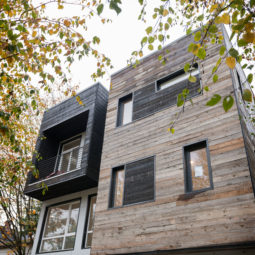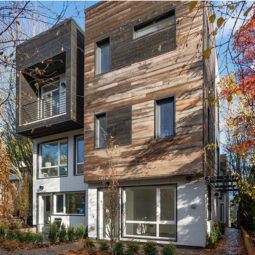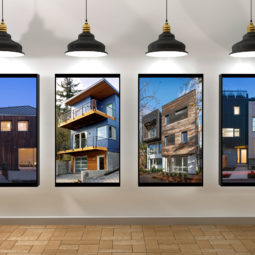Our Passive House project, Park Passive, was recently featured in the New York Times! Read the article down below.
The Passive House: Sealed for Freshness
By Sandy Keenan of the New York Times
Aug. 14, 2013
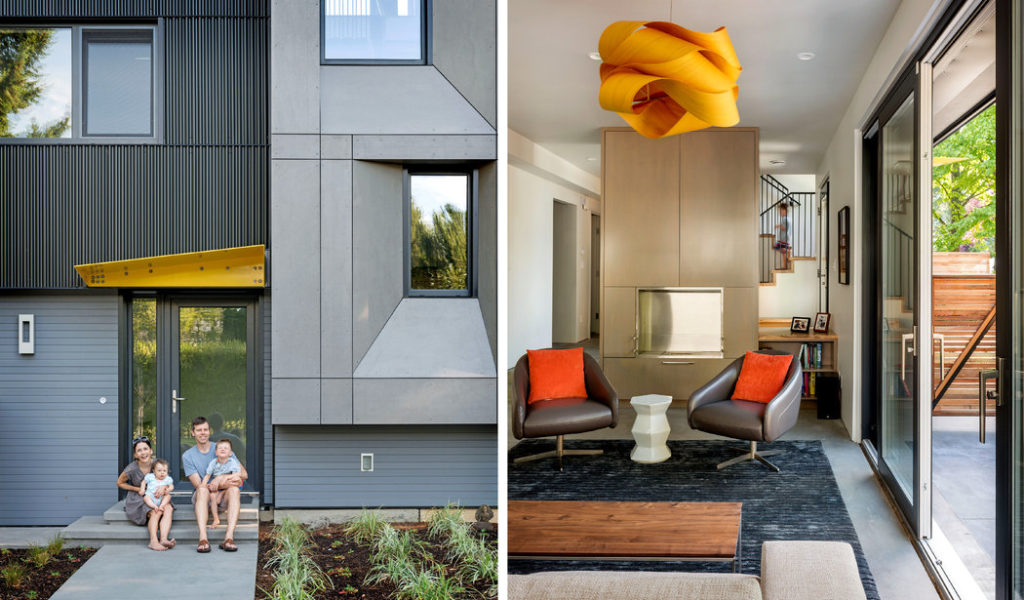
SEATTLE — When you visit Sloan and Jennifer Ritchie’s new passive house in the Madison Park neighborhood here, it takes a while to notice all the things you’re not hearing.
Look out the living room windows and you can see a gardener wielding one of those ear-piercing leaf blowers in the yard, but you would never know it inside.
There is no furnace or air-conditioner clicking on or off, no whir of forced air, and yet the climate is a perfect 72 degrees, despite the chilly air outside.
Then there are the things you’re not feeling. In one of the most humid cities in the country, you aren’t sticky or irritable, and the joints that sometimes bother you are mysteriously pain-free.
The air inside the house feels so fresh, you can almost taste its sweetness.
On paper, at least, the Ritchies’ home sounds too good to be true: an environmentally responsible house without traditional heating and air-conditioning systems that will be an airy 70 to 74 degrees on the coldest day of winter and the hottest day of summer, but use only a fraction of the energy consumed by a typical house.
And yet it’s not some experiment or futuristic dream. Nearly 30,000 of these houses have already been built in Europe. In Germany, an entire neighborhood with 5,000 of these super-insulated, low-energy homes is under construction, and the City of Brussels is rewriting its building code to reflect passive standards.
But in the United States, since the first passive house went up 10 years ago, in Urbana, Ill., only about 90 have been certified. Why aren’t they catching on here?
Part of the problem is the cost. Higher fuel prices and energy taxes in Europe provide a major incentive to embrace passive standards, which are complicated and make construction more expensive. In this country, it could be a decade or more before the energy savings someone like Don Freas enjoys in his 1,150-square-foot passive house in Olympia, Wash., offsets the extra $30,000 or so it cost to build.
“But those are such non-sexy ideas,” said Mr. Freas, 61, who is a sculptor and poet. “What matters is that I have never lived in such a comfortable house.”
Proponents of passive building argue that the additional cost (which is estimated at 5 to 20 percent) will come down once construction reaches critical mass and more American manufacturers are on board. And there are a few signs that day may be coming. More than 1,000 architects, builders and consultants have received passive-house training in this country; at least 60 houses or multifamily projects are in the works; and Marvin Windows, a mainstream manufacturer based in Minnesota, recently began making windows that meet passive certification standards.
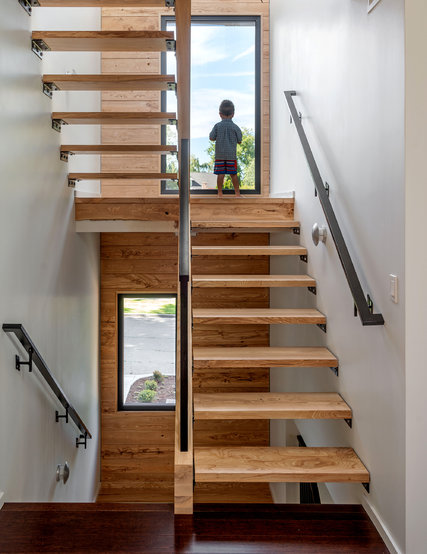
The wood from a spruce tree on the site that could not be saved was used throughout the house for the stairs and walls. Credit Aaron Leitz
For all that, there are plenty of people who aren’t buying it — even some of those who support passive principles.
Martin Holladay, 58, a respected voice within the building industry, writes the Musings of an Energy Nerd blog for greenbuildingadvisor.com and lives off the grid in Vermont. He doesn’t believe passive houses are right for the American market.
“What I’m worried about,” he said, “is that the current halo around the passive-house standard will result in its being incorporated into the building code. That would be unfortunate because they are unnecessarily expensive houses, from $300,000 to $500,000 on average, that cost more than will ever be justified by lifetime energy savings or carbon reductions.”
Mr. Holladay favors a more flexible formula called the Pretty Good House, which promotes modest improvements in insulation coupled with renewable energy from solar panels — an approach, he said, that achieves similar energy savings without the additional expense.
BUT COST IS NOT the only hurdle. The very idea of a passive house is counterintuitive. And when just explaining what it is remains so difficult, proselytizing is that much harder.
As Mr. Freas said, “It’s like trying to describe an environment that we, as Americans, have no experience with.”
The basic idea is that these houses are so airtight that warm air won’t leak out in the winter, and cool air won’t leak out in the summer. Windows are three panes thick, and there is far more insulation than you would find in a standard American home.
Stale indoor air is exchanged for fresh outdoor air without altering the internal temperature by mechanical systems you would not find in a conventional house: things like heat-recovery ventilators, which draw the heat from outgoing air and mix it with incoming air from outside in the winter, and do the opposite in the summer. (In high-humidity climates, an energy-recovery ventilator is used instead to strip moisture from incoming air.)
Vents that look like small, round audio speakers are placed throughout the house to exchange fresh air. These devices have prevented the formation of mold, which plagued the passive-solar movement of the 1970s and 1980s.
This system is based on a complex formula devised in the early 1990s by the German physicist Wolfgang Feist, which has been used for residential and commercial projects of various sizes, including a college dormitory recently completed in Virginia.
To be certified, a project must meet three crucial benchmarks. The first is a certain level of airtightness, as determined by a “blower door test.” The other two are measures of energy use: the annual energy consumed by heating and cooling the space cannot exceed a certain amount, and neither can the energy consumed by a range of other things, like heating water and powering electronic devices. Failure to properly meet these three markers (while also paying attention to variables like climate and orientation to the sun) means a building may not achieve optimum performance. Nor will it receive approval from either of the passive certifying bodies operating in the United States, which can charge thousands of dollars in fees.
To make things more complicated, no two passive houses are likely to be built to exactly the same specifications. Thousands of variables, including the architectural design, the size of the house, how many people will live there, and longitude and latitude, are taken into consideration by the sophisticated software created by Dr. Feist and his Passivhaus Institute in Darmstadt, Germany.
The first time Mr. Freas’s design team tried the computer modeling, it took them 100 hours. Now they have it down to 6.
And that’s before the real work begins. During construction, special fog machines and infrared cameras are often brought in to detect the smallest air leaks. Special tapes, gaskets and sealants are used on the wall seams to ensure they won’t break down over time and result in drafts.
And the more extreme the weather, the more insulation is needed. In a place as cold as Minnesota, a passive home’s walls would have to be 18 inches thick, but even in the more temperate Portland, Ore., 12 to 14 inches is typical.
This kind of meticulous construction results in big energy savings, but just how much is a matter of some dispute. Passive House advocates claim their buildings require 10 to 35 percent as much energy as standard buildings, while others, like Mr. Holladay, put that at closer to 50 percent.
Either way, getting it right is tricky, which is why 32 builders, architects and consultants recently gathered for a four-day training session in Seattle run by the Passive House Institute United States, which is based in Urbana. Many had beginners’ horror stories. One representative of Habitat for Humanity in Washington State introduced himself by saying, “I’m here because the passive house we built failed, and I need to understand what went wrong so it never happens again.”
Katrin Klingenberg, 44, the German-born architect who leads the institute, has been at the forefront of the American movement. As far as she is concerned, “Washington and Oregon are a piece of cake for passive house design,” she said.
More than a third of the certified passive houses are in the Pacific Northwest, probably because the conditions are perfect, she said. “It doesn’t get too cold in the winter or too humid in the summer. It’s most similar to Europe.”
Figuring out how to make the model work in the hot, humid Southeast is a bigger challenge, something the Europeans have not had to deal with. With this in mind, Ms. Klingenberg’s organization is working to develop American standards, taking into account variations in energy use and leakage rates from one climate zone to another; they are expected to be released this fall.
As Joseph Lstiburek, an engineer with the Building Science Corporation, a research facility in Boston, put it, “there’s a really big difference between Minneapolis and Miami.” The German model doesn’t take that into account, he said. “The Germans don’t know how to do air-conditioning or humidity.”
Those differences have contributed to a two-year stalemate between the German and American passive house institutes, which have stopped collaborating on software, testing and certification. That puts designers here in an awkward position.
The Artisans Group, in Olympia, Wash., which designed and built Mr. Freas’s home, has decided to split its six new passive projects, collaborating with the Germans on some and the Americans on others, said Tessa Smith, a co-owner of the firm. “That way we will learn more,” she said.
But for those who are hoping to push the industry forward in this country, the split is disheartening, said Sam Hagerman, president of the Passive House Alliance, an association of passive house professionals, and the owner of Hammer and Hand, a construction company in Portland. Particularly, he said, when “we’re still trying to show proof of concept.”
WHILE THEIR BLACK, fiber-cement-paneled house was going up in a neighborhood of traditional million-dollar homes, the Ritchies couldn’t help noticing the openly hostile stares. Mr. Ritchie, 42, a wireless engineer turned sustainable builder and developer, speculated, “They probably wanted something Craftsman here.”
Ms. Ritchie, 39, who owns a public relations firm, said: “We could have toned it down. Our architect came up with six color schemes for the exterior.” Instead, they went with the boldest option, black.
They also put out a sign explaining in simple terms how the house is so energy-efficient that it will run on the same amount of power it takes to operate a hand-held hair dryer. After that, Mr. Ritchie said, “the negative feedback went back to almost zero.” An elderly woman gave him a big thumbs-up. Others stopped to chat.
But not everyone was won over. One man walked up to Mr. Ritchie and said, “I really don’t like what you’re doing with your house.”
Later, Mr. Ritchie realized what his comeback should have been: “And I don’t like what you’re doing with your furnace.”
Early passive houses were boxy, with few windows and even less style, but as designers have grown more comfortable with the modeling software, homes have become more elegant and inventive. In the Ritchies’ house, everything feels textured and substantial, like the metal-framed windows from Lithuania, the skylights from Poland, and the touches of spruce throughout, which came from a tree on the long, thin lot that had to come down.
Building it has been a learning experience for Mr. Ritchie, one he intends to continue, he said. But now he plans to build passive houses to sell.
“To me, the saddest thing is taking apart a building from the 1950s and realizing, ‘Is this all we’ve done in 60 years: added an inch or two of insulation?’ ” he said. “We can do better.”
Correction: August 22, 2013
An article last Thursday about so-called passive houses, which save energy by tight weather sealing, misspelled the surname of a couple who built such a house in Seattle. They are the Ritchie family, not Richie. The article also referred incorrectly to Hammer and Hand, a company in Portland, Ore., and Seattle. It is a construction company, not a design-build firm. And a diagram accompanying the article illustrating a heat-exchanger reversed the direction of two arrows. The red arrow demonstrating the movement of stale air from an interior should have pointed down, and the blue arrow indicating the movement of fresh air into rooms should have pointed up.

